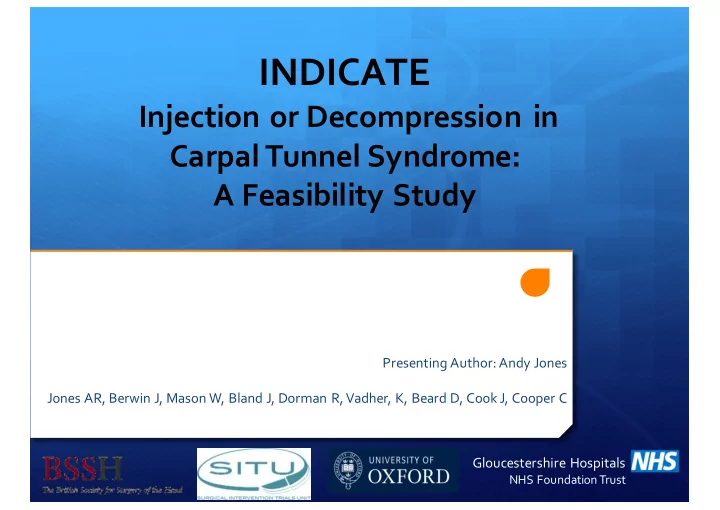

INDICATE Injection or Decompression in Carpal Tunnel Syndrome: A Feasibility Study Presenting Author: Andy Jones Jones AR, Berwin J, Mason W, Bland J, Dorman R, Vadher, K, Beard D, Cook J, Cooper C Gloucestershire Hospitals NHS Foundation Trust
AIMS Aim of the proposed trial: Ê To assess whether surgical decompression or a single steroid injection is the better treatment for patients with moderate carpal tunnel syndrome Aims of the Feasibility trial: Ê To assess the study design in terms of: Ê study protocol Ê methods of identification Ê recruitment and retention success Ê possibility of NCS in all participants
Patient Selection Clinical diagnosis of CTS in adult: Exclusion criteria: Ê intermittent parasthesiae in Ê clinically severe CTS median nerve distribution Ê Nocturnal symptoms Ê secondary CTS, Ê Positive provocation test Ê previous injection Moderate severity: Ê other peripheral neuropathy Ê > 3 months duration Ê Failed 2 weeks of night splints Ê concomitant hand disorder Ê Disturbed sleep or difficulty Ê cognitive difficulties performing activities of daily living
Recruitment Ê 5 sites for identification Ê Gloucestershire Ê Primary care –from databases of 20 GP practices Ê Secondary care –referrals to one hand surgeon Ê Canterbury – dedicated neurophysiology CTS service Ê Plymouth – referrals to two hand surgeons Ê Somerset - 2 physiotherapy interface service s Ê 40 patients recruited
Interventions & outcomes Randomly allocated to either: Ê Single steroid injection or Ê Carpal tunnel decompression (surgeon’s usual technique) Ê Patients offered further treatment if symptoms persist/recur Ê Postal follow up – 1, 3, 6 and 12 months Ê 1 o Outcome – Change in Symptom Severity Score at 1 year
Recruitment RESULTS 40 8 Monthly Rectuitment Target 35 7 Total Rectuitment Target Ê 40 patients recruited across 2 sites 30 6 Ê Gloucestershire – patients identified in both primary and 25 5 secondary care 20 4 15 3 Ê 17 men : 23 women 10 2 Ê 20 patients in each group 5 1 0 0 November December January February March April 2016 May 2016 June 2016 July 2016 August 2015 2015 2016 2016 2016 2016 Recruitment Period in Months Monthly Total Target Monthly Recruitment Monthly Total Target Total Recruitment
Recruitment 90 81% 80 70 60 50 40 Eligible 32% 54% 30 Recruited 20 10 0
Change of status Ê 2 patients changed treatment allocation after recruitment: Ê 1 randomisedfor surgery but declined and had injection Ê 1 randomisedto surgery but symptoms improved before operation -had no treatment Ê N = 38
Participant retention % returned questionnaires 100 90 80 70 60 50 40 30 20 10 0 1 month � 3 months � 6 months 12 months
Participant retention 100 90 80 70 60 50 Injection 40 Surgery 30 20 10 0 1 month � 3 months � 6 months 12 months
Primary Outcome - Symptom Severity Score 4 3.5 3 Injection 2.5 Surgery 2 1.5 1 Baseline 1 month 3 months 6 months 12 months
Nerve Conduction Studies Ê 39 patients underwent NCS 12 10 8 6 INJECTION SURGERY 4 2 Canterbury Grade 0 0 1 2 3 4 5 6
Expected Adverse Events Ê Infection (CDC definition of superficial incisional SSI) Ê Nerve injury (permanently reduced sensibility or power) Ê Vessel injury (sup palmar arch injury/haematoma drainage) Ê CRPS (Budapest criteria) Ê None reported
Additional Treatment Ê Surgical group: Ê 1 patient had early recurrence of symptoms and required revision CTR 1 year later (also ulnar nerve release) Ê Injection group: Ê 8/21 patients required surgery within 1 year of injection Ê 1 patient had no change in symptoms and was dissatisfied (received 2 nd injection, also no effect. Normal NCS)
Conclusions Ê Recruitment of patients with moderate primary CTS with no previous injection is possible Ê Identification through primary care does work, but requires more effort and expense Ê Retention is adequate - 74% at 1 year Ê NCS no problem in these 2 sites
The Future Ê A trial is possible – current trial protocol is functional Ê Careful site selection is required. Increasingly difficult with CCG stance towards surgery – aim for 20 nationwide Ê Retention could be improved Ê by omitting 1 and 3 month follow up Ê by offering online Ê Similar trial submitted for NIHR funding – awaiting decision.
Acknowledgements Ê Will Mason – Chief Investigator Ê Jeremy Bland – Principle Investigator Ê James Berwin, Danny Ryan, Asif Khan, Hui-Ling Kerr Specialist Trainees T&O, Severn Deanery Ê David Beard, Jonathan Cook, Ines Rombach, Cushla Cooper, Rachel Dorman Surgical Intervention Trials Unit, NDORMS, Oxford
?
Recommend
More recommend